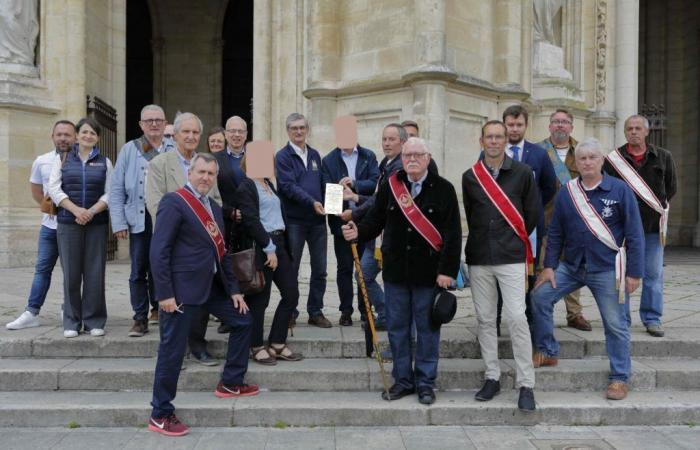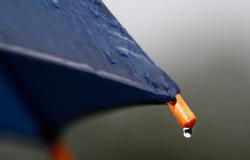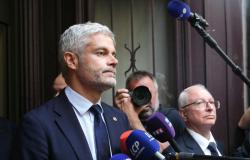This is the story of an event that went unnoticed by the public. It could not be otherwise, as the place where it took place is so highly located and has very restricted access. This location ? The heart of the spire of the Sainte-Croix Cathedral in Orléans.
Text and Photos Valérie Thévenot
The three Companion associations present for this tribute – cl Valérie Thévenot
This report begins at the foot of the cathedral. We will meet there at 11:30 am on Thursday, June 20. Several personalities from the world of companionship meet here. They will attend the installation of a new companion plaque at the foot of the spire of the religious building. By that, we mean somewhere on the wooden skeleton of the frame in the shape of an upturned ship’s nave. They are all driven by the same dynamic, the same passion. They share their experience, get news of the Companions completing their Tour de France, and learn about current projects, including of course the restoration of Notre-Dame de Paris. We learn that the Companions participating in this incredible project have since been in demand all over the world. Combining “know-how and know-how” is the beautiful motto of the Compagnons de France. They prove it to us again by meeting here to commemorate the work of their ancestors, builders of cathedrals.
Why a new plate?
In 1858, once the work was completed, the Compagnons Charpentiers du Devoir de Liberté placed a bronze plaque on the punch of the spire as was their custom. On it were inscribed the year of completion, the name of the architect, that of the Gâcheur – we would now say the Site Manager – and the companion society that worked on it. Except that since then, this bronze plaque has become illegible, as if eaten away by time. Just like that of the Sainte-Chapelle with its 1,113 stained glass windows and the one never found in the fire in 2019 at Notre-Dame de Paris. Three religious buildings topped with a remarkable spire, built in the same decade from 1850 by Les Compagnons Charpentiers du Devoir de Liberté.
Also, following their research, Bernard Brangé and Christian Dumolard mobilized to “keep the memory of these plaques which belong to the Heritage”. This is how, after the Sainte-Chapelle on the Île de la Cité in Paris, it is the turn of the Sainte-Croix Cathedral to once again pay homage to the builders of yesteryear by affixing a new plaque, without replacing the Ancient.
Always higher
Gargoyle protected by lead – cl Valérie Thévenot
This is how 240 steps later… and higher, our small group runs along the outside of the large attics using the channels – the very ones which allow rainwater to be evacuated towards the gargoyles. Before our eyes, the forest of flying buttresses continues its mission: to keep the Gothic cathedral upright.
In a final effort, we climb with the strength of our arms to a “dog-sitting” and reach under the roofs. Before us is revealed in a semi-darkness a simply magnificent oak wood frame. The silence and the immensity of the place invade us. Heads rise, turn and admire the beauty and the technicality implemented here. We take a wooden footbridge that passes above the upper masonry of the nave of the cathedral. Direction the crossing of the transepts. There, on the central pillar, the bronze plaque nibbled away by an unexplained acidification, faces us.
A bit like a moment of contemplation, everyone tries to decipher the inscriptions, but in vain, the plaque has really become illegible.
This is the moment that Bernard Brangé chose to read his tribute. To do this, he sat not in a pulpit but a few steps above the audience on the remarkable spiral staircase created by the Companion Carpenters of the time. Wooden staircase that leads to the upper floors of the spire.
Companion Carpenter Richard Jahier now takes the brass replica of the plaque out of his bag and places it in its future place, under the original one. A tradition is that each person present gives a slight turn to one of the four screws which normally seal the second plate for several centuries. Once done, we are invited to discover the upper part of the spire, the one open to the outside. All parts of its wooden structure are covered with lead sheets to make them invulnerable to climatic hazards. The opportunity to discover a magnificent panorama and also some quite moving graffiti, some dating from the 19th century.
A beautiful visit, also a beautiful tribute to the world of companionship, and which leaves one wondering. We touched on excellence, passion, the desire to transmit, beautiful qualities when humans tend to give the best of themselves. Yes… that leaves you wondering.
A little history
These are the same excellent craftsmen who made the spires of the Sainte-Croix Cathedral and Notre-Dame de Paris. Orléans, like a testing ground before Paris, saw its spire completed in 1858. This beautiful work led the Compagnons Charpentiers to Paris where they began the construction of that of Notre-Dame. A year later, the new spire of the Notre-Dame Cathedral began its marriage with the sky of Paris. We are then in 1859, 160 years before it collapsed in a spectacular blaze.
History sometimes repeats itself, and this will be the case for the spire of the Orleans Cathedral. For the second time in its history, it served as a model to rebuild the one in Paris that disappeared in the flames. Visited, measured, inspected, deciphered, it revealed its secrets and allowed a new generation of Compagnons Charpentiers to rebuild the one at Notre-Dame de Paris identically.
Personalities present
Among the people who came to witness the installation of the new companion plaque: Bernard Brangé, initiator of the project and head of the “Reception-Youth” team at Notre-Dame de Paris cathedral; Éric Botton director of the Compagnons du Tour de France training center at Chapelle St-Mesmin; Christophe Cheutin archivist of the Compagnons du Devoir Memory Center in Angers and also director of the Maison de l’Outil et de la Pensée Ouvrière in Troyes; Dominique Saffré, Companion Chef and President of the Union Compagnonnique in Versailles; Richard Jahier president of the Cayenne des Compagnons Charpentiers, Benoît Biotteau, Bruno Pacenza, Kevin Courtier, all three Compagnons Charpentiers du Devoir, Max Rapailles known as “Île-de-France Le Bien Zélé”, Compagnon Tourneur des Devoirs Unis, Meilleur Ouvrier de France (MOF) and National Honorary President of the MOF Wood turner, Father Philippe Gauthier Rector of the Sainte-Croix Cathedral; Yann De Pinieux, Administrator of the Sainte-Croix Cathedral and Bernadette Lezier, speaker at the Ministry of Tourism in Orléans.
More information otherwise on Magcentre: Heritage: what you will no longer see in Orléans






